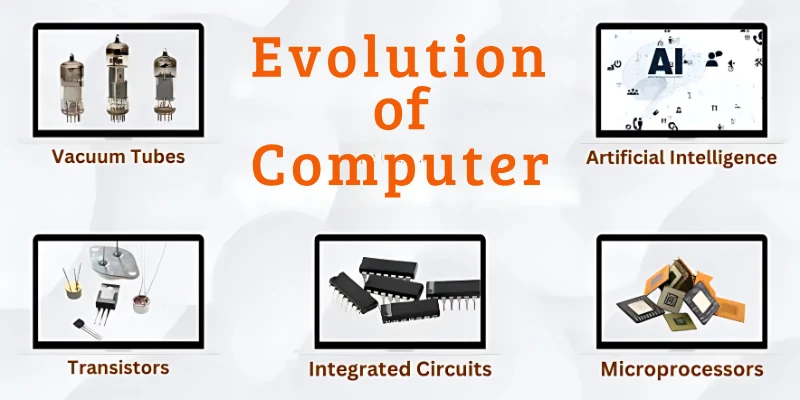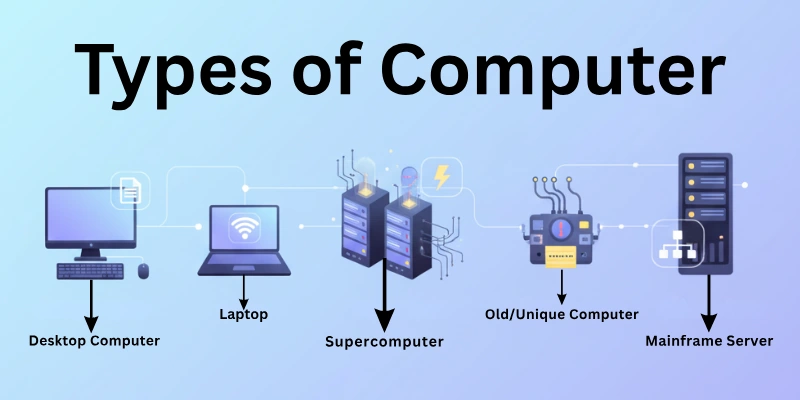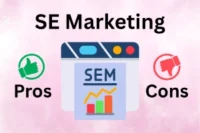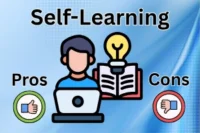Computer Basics: What is Computer?
Published: 18 Aug 2025
A computer has become an essential in our daily lives. It plays a crucial role in various fields, from education to business, making tasks easier and more efficient. Over time, computers have evolved significantly from their early forms.

They started as large, room-sized machines and have transformed into the compact, high-speed devices we use today. The shape and functionality of computers have changed, but their core purpose remains the same.
So, guys, in this article, we will explore:
- What is a computer?
- How has the computer evolved?
And
The many ways it benefits us!!!!
First, I’m starting with the computer’s definition; after that, we will move on to other parts like history, uses, types, and much more!
What is Computer?
Computer is an electronic machine that takes input from the users in the form of data and then processes it into the form of information as a result of output. Computers can store, retrieve, and process data. And as it is made up of electronic components, it needs electricity to operate.
Here is the full form of computer:
- C – Common
- O – Operating
- M – Machine
- P – Purposely
- U – Used for
- T – Technological and
- E – Educational
- R – Research
From this abbreviation you can see that we can use computers for different purposes, either as a source of pleasure or for any academic task. Before diving further into the computer’s details, let’s get through its history.
History of Computer
Here is the historical development of computers in detail.
1. Abacus
The abacus is one of the earliest known tools for computation. Invented around 2400 BCE, it consists of a series of rods with beads that can be moved to perform arithmetic calculations like addition, subtraction, multiplication, and division.
2. Mechanical Calculators
- Pascaline: Invented by Blaise Pascal in 1642, the Pascaline was one of the first mechanical calculators. It used gears and wheels to add and subtract numbers.
- Leibniz Wheel: Developed by Gottfried Wilhelm Leibniz in the 1670s, this mechanical calculator improved on Pascal’s design. It could perform multiplication and division through a stepped-drum mechanism.
3. Charles Babbage’s Machines
- Difference Engine: Conceived by Charles Babbage in the early 1820s, the Difference Engine was designed to automatically compute and print mathematical tables. Although Babbage never completed it, modern reconstructions have proven its feasibility.
- Analytical Engine: Babbage’s later design, the Analytical Engine (1837), was a more advanced concept that included elements of a modern computer, such as a central processing unit (CPU), memory, and input/output mechanisms. It was programmable using punched cards, much like early 20th-century computers.
Evolution of Computers
Here is how the computer evolved:

1. First Generation (Vacuum Tubes)
- These computers, developed in the 1940s and 1950s, used vacuum tubes to amplify and switch electronic signals.
- They were large, expensive, and consumed a lot of power.
- Examples include the ENIAC (Electronic Numerical Integrator and Computer) and UNIVAC (UNIVersal Automatic Computer).
2. Second Generation (Transistors)
- The second generation, from the late 1950s to the mid-1960s, saw the replacement of vacuum tubes with transistors.
- Transistors were smaller, more reliable, and more energy-efficient.
- This generation of computers was faster and more affordable, exemplified by the IBM 7090 and the PDP-1.
3. Third Generation (Integrated Circuits)
- Integrated Circuits (ICs), which combine many transistors into a single chip, marked the third generation in the mid-1960s to early 1970s.
- ICs significantly reduced the size and cost of computers while increasing their power and reliability.
- Notable examples include the IBM System/360 and the PDP-8.
4. Fourth Generation (Microprocessors)
- Starting in the 1970s, the fourth generation of computers used microprocessors, which integrate the computer’s CPU (Central Processing Unit) onto a single chip.
- This innovation led to the development of personal computers (PCs).
- The Intel 4004, released in 1971, was the first microprocessor.
- This era also saw the rise of companies like Apple and Microsoft.
5. Fifth Generation and Beyond (Artificial Intelligence, Quantum Computing)
- The fifth generation of computing, from the 1980s to the present, focuses on artificial intelligence (AI) and advanced computing technologies.
- AI aims to create systems that can learn and make decisions.
- Quantum computing, an emerging field, uses the principles of quantum mechanics to perform complex calculations much faster than traditional computers.
- These advancements promise to revolutionize fields like cryptography, medicine, and finance.
How Does Computer Work?
In the above section we have covered the basic definition of a computer and a detailed history of how the computers evolved and how they changed their bulky styles into slim and smart laptops.
In the definition part I’ve mentioned a computer that processes the data and then converts it into useful information. But is all this procedure done?
Here is how it works:
1. Input
Input is the data that you provide to the computer. This can be in the form of text, images, or any other information. You give this data to the computer using input devices such as a keyboard, mouse, scanner, or microphone.
Examples of Input Devices:
- Keyboard: Used to type text and numbers.
- Mouse: Used to point, click, and select items on the screen.
- Scanner: Used to digitize documents and photos.
- Microphone: Used to input sound.
2. Processing
Processing is the action the computer takes to convert input data into useful information. The CPU (Central Processing Unit) is the brain of the computer, and it performs this task. The CPU carries out instructions from programs or software to manipulate the data.
Components Involved in Processing:
- CPU: Executes instructions and processes data.
- RAM (Random Access Memory): Temporarily stores data and instructions that the CPU needs while working.
- Motherboard: The main circuit board that connects all components of the computer.
3. Storage
Storage refers to saving data and instructions for future use. There are two main types of storage: primary storage (RAM) and secondary storage (hard drives, SSDs).
Examples of Storage Devices:
- Hard Drive (HDD): Uses magnetic storage to store data.
- Solid State Drive (SSD): Uses flash memory for faster storage.
- USB Flash Drive: Portable storage device.
- Cloud Storage: Stores data on remote servers accessed via the internet.
4. Output
Output is the information that the computer provides after processing the input data. This information is displayed to the user through output devices.
Examples of Output Devices:
- Monitor: Displays text, images, and videos.
- Printer: Produces physical copies of documents and images.
- Speakers: Output sound.
- Projector: Projects images and videos onto a larger screen.
- Feedback Loop
Sometimes, the output information is used as new input for further processing. This continuous cycle is known as a feedback loop.
Example of How a Computer Works
Let’s say you want to write a letter and print it out:
- Input: You type the letter using a keyboard (input device).
- Processing: The CPU processes your typing, storing the text temporarily in RAM.
- Storage: You save the letter on your hard drive (storage device).
- Output: You print the letter using a printer (output device).
Components of Computers
A computer system consists of two major parts: hardware and software.

Hardware
Hardware refers to the physical components of a computer system that you can touch and see. These components perform the essential tasks needed for the computer to operate.
1. Central Processing Unit (CPU)
Definition and Functions: The CPU, often referred to as the “brain” of the computer, executes instructions from programs, performs calculations, and manages data flow within the computer.
Types of CPUs:
- Single-core: Contains one processing unit.
- Multi-core: Contains multiple processing units (cores), allowing for parallel processing and better performance for multitasking.
2. Memory
Definition: Memory is the component that stores data and instructions needed for processing by the CPU.
RAM (Random Access Memory)
- Definition: RAM is a type of volatile memory that temporarily stores data and instructions that the CPU needs while performing tasks.
- Functions: Provides fast read and write access to data, enhancing the speed and efficiency of running applications.
ROM (Read-Only Memory)
- Definition: ROM is a type of non-volatile memory that permanently stores essential instructions for the computer’s boot process.
- Functions: Holds firmware, ensuring the computer can start up and load the operating system.
3. Storage Devices
- Definition: Storage devices are hardware components that store data permanently or semi-permanently.
Hard Disk Drives (HDD)
- Definition: Uses magnetic storage to store data on spinning disks.
- Functions: Provides large-capacity, cost-effective storage for files and applications.
Solid State Drives (SSD)
- Definition: Uses flash memory for data storage.
- Functions: Offers faster data access and better reliability than HDDs.
External Storage
- USB Drives: Portable storage devices using flash memory.
- Cloud Storage: Remote storage accessed via the internet, allowing data to be stored and retrieved online.
4. Input Devices
Input devices are hardware components used to provide data and control signals to the computer.
- Keyboard: Allows the user to type text and commands.
- Mouse: Enables the user to point, click, and select items on the screen.
- Scanners: Digitize documents and images.
- Microphones: Input sound.
5. Output Devices
Output devices are hardware components that present data and information to the user.
- Monitors: Display text, images, and videos.
- Printers: Produce physical copies of documents and images.
- Speakers: Output sound.
- Projectors: Project images and videos onto a larger screen.
Software
Software refers to the programs and other operating information used by a computer. It enables hardware to perform specific tasks.
There are two types of computer software:
- System Software
- Application Software
Let us learn about them.
1. System Software
System software is designed to manage and control the hardware components and provide a platform for running application software.
Operating Systems (OS)
- The OS manages hardware and software resources on a computer.
- Examples: Windows, macOS, Linux.
Utility Programs
- Utility programs perform maintenance tasks to ensure the efficient operation of the computer.
- Examples: Antivirus software, disk cleanup tools.
2. Application Software
- Application software consists of programs designed to help users perform specific tasks or applications.
Productivity Software
- Programs designed to help users produce documents, spreadsheets, presentations, and other work-related tasks.
- Examples: Word processors, spreadsheet applications.
Multimedia Software
- Programs used for creating and editing images, videos, and audio.
- Examples: Photo and video editing software.
Internet Browsers
- Programs that allow users to access and navigate the internet.
- Examples: Chrome, Firefox, Safari.
Types of Computers
The types of computer is four categorised into five main parts:

- By Form Factor
- By Purpose
- By Architecture
- By Operating System
- And Other Classifications
To learn about each type with sub-types in detail you can visit here.
Computer Networks
A computer network is a group of computers connected together to share resources, such as files, printers, and internet access. These connections can be made using cables, wireless signals, or other communication methods.
Importance:
- Resource Sharing: Networks allow multiple computers to share hardware (like printers) and software (like applications).
- Communication: Enables people to communicate through email, instant messaging, and video conferencing.
- Data Access: Facilitates access to information stored on other connected devices.
- Efficiency: Improves productivity by enabling real-time collaboration and resource sharing.
Types of Networks
There are four main types of computer network:
- LAN – A LAN is a network that connects computers within a small area, such as a single building or a campus.
- WAN – A WAN covers a large geographical area, connecting multiple LANs. It can span cities, countries, or even continents.
- MAN – A MAN is a network that spans a city or a large campus. It is larger than a LAN but smaller than a WAN.
- PAN – A PAN is a small network used for connecting devices close to a single person, typically within a range of a few meters.
Internet and World Wide Web
- The internet is a global network of interconnected computers that communicate through standardized protocols.
- Structure: It consists of a vast number of smaller networks (like LANs and WANs) connected together. The internet uses routers and switches to manage data traffic and ensure data reaches its destination.
Software Development
Software development involves creating programs, applications, and systems that run on computers and other devices. Its purpose is to solve problems, automate tasks, and provide functionality to users.
Programming Languages
Programming languages are tools used by developers to write instructions that computers can understand and execute.

1. Low-level languages
- Low-level languages are close to machine code and are more difficult for humans to read and write directly.
- Examples: Assembly language, Machine code.
- Purpose: Used for tasks that require precise control over hardware, such as device drivers and operating system development.
2. High-level languages
- High-level languages are easier for humans to read and write, as they are closer to natural language.
- Examples: Python, Java, C++.
- Purpose: Used for general-purpose programming, web development, data analysis, and more. They abstract away low-level details, making coding more efficient.
Impact of Computers on Society
Here are some advantages and disadvantages of computers.
Positive Impacts
Computers have brought about profound changes in how we work, learn, and communicate, enhancing our efficiency and opening up new opportunities. So, here are some major benefits of computers:
1. Efficiency and Productivity
Computers automate difficult operations, improve workflows, and handle large amounts of data quickly and accurately. This leads to increased productivity in fields such as business, healthcare, and manufacturing.
2. Access to Information and Education
The internet, powered by computers, provides an unlimited supply of information and educational tools. Online courses, digital libraries, and instructional tools enable anyone to learn from anywhere in the world.
3. Communication and Collaboration
Computers enable instant communication through emails, messaging apps, and video conferencing. Collaboration platforms and tools let people work together in real time, even if they are in different places. This encourages teamwork and creativity.
Negative Impacts
While computers offer many benefits, they also present several challenges that require attention to ensure the safe and equitable use of technology. So here are the major cons of using a computer:
1. Cybersecurity Threats
As more activities take place online, the risk of cyber threats such as hacking, phishing, and malware grows. These dangers can result in hacking of data, financial losses, and leaked personal information.
2. Privacy Concerns
The large amount of personal data that is saved and shared online causes privacy issues. Companies’ data collecting, government tracking, and data leaks can all put people at risk of unwanted attention and abuse.
3. Digital Divide
The digital divide is the difference between those who have access to computers and the internet and those who don’t. This inequality can result in unequal opportunities for education, work, and access to information, causing social and economic injustices.
Conclusion
So, in this article, we’ve covered everything about “What is Computer,” from its basic definition to how it impacts our lives, both positively and negatively.
Looking ahead, here’s some advice: keep exploring and learning about computers and new technologies. The future of computers is exciting with things like smarter machines and new ways to use computers. These changes can help improve healthcare, business, and our daily lives.
But as we use computers more, we need to think about how to keep our information safe and respect people’s privacy. By learning and staying curious, we can help make sure computers make our world better while keeping it safe for everyone.
FAQs
Here are some of the most commonly asked questions related to “What is Computer”:
A computer is an electronic machine that takes input, processes it, and gives output. It works by following instructions and can perform many tasks like calculations, writing, or running programs.
Many people use “COMPUTER” as an acronym for Common Operating Machine Particularly Used for Technical, Educational, and Research. But in reality, it is not an official full form—it’s just a made-up expansion
Charles Babbage is called the “Father of Computers”. He designed the Analytical Engine in the 1800s, which became the base idea for modern computers.
Hardware refers to the physical components of a computer that you can touch, like the CPU and keyboard. Software is a set of instructions or programs that tell the hardware what to do, such as operating systems and applications.
Computers store information digitally using binary code (0s and 1s) in electronic circuits. The Central Processing Unit (CPU) processes this data by executing instructions from software, performing calculations, and managing input/output operations.
Computers are used in various applications such as:
- Business: for accounting, inventory management, and data analysis.
- Education: for research, online learning, and simulations.
- Healthcare: for patient records, diagnostic imaging, and medical research.
- Entertainment: for gaming, streaming media, and virtual reality.
- Communication: for email, social media, and video conferencing.
- Science and Engineering: for simulations, modeling, and design.

- Be Respectful
- Stay Relevant
- Stay Positive
- True Feedback
- Encourage Discussion
- Avoid Spamming
- No Fake News
- Don't Copy-Paste
- No Personal Attacks

- Be Respectful
- Stay Relevant
- Stay Positive
- True Feedback
- Encourage Discussion
- Avoid Spamming
- No Fake News
- Don't Copy-Paste
- No Personal Attacks





